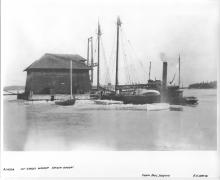Font Size
About North Haven
A Brief History of North Haven

That Red Paint People and Pre-Algonkians inhabited North Haven as early as 3300 B.C has been established with evidence from charcoal samples and artifacts. Native Americans and Europeans fished the waters surrounding the island for many years, but the credit for “discovering” it traditionally goes to Martin Pring who, in 1603, gave the name "Fox Islands" to the islands now known as Vinalhaven and North Haven.
The first permanent settlers of the island of European descent arrived in the 1760’s. As the population increased, trees were felled to build homes and farming and fishing were the major occupations. It was not until 1786 that the petition of these settlers for clear title to their lands was approved by the General Court of Massachusetts. Over the course of the next 80 years or so, as Norwood Beveridge tells us in The North Island (1976), the settlement "… had passed from one nation to another, been a part of both Massachusetts and Maine, belonged to four different counties – Lincoln, Hancock, Waldo and Knox, and worn four different names – Fox Islands Plantation, Vinalhaven, Fox Isle, and North Haven."
In 1852, North Haven's population peaked at about 1000 and in recent years has remained steady at about 350-380 full time residents. At least six stores and six school districts served that larger nineteenth century population. Pulpit Harbor with its own post office was a thriving commercial district. Presently there is one general store, three gift stores and one post office. The accredited Kindergarten through Grade 12 school serving between 75 and 80 students is key to the island's year round sustainability.
Among the businesses that appeared in the second half of the nineteenth century were a clam and lobster factory. Boat building became a prominent industry and to this day, there are two active boatyards on the island. Mackerel fishing peaked in the late 1800s with a dozen or so two-masted schooners. Fishing today is predominantly lobstering, scalloping for a few fishermen, and raising oysters for another.
In the 1880’s, summer "rusticators" discovered the island. They arrived first from Boston and a decade or two later from New York and Philadelphia. They built their cottages on both sides of the Thoroughfare that separates North Haven and Vinalhaven and later established another summer colony at Pulpit Harbor. Their descendants and increasing numbers of seasonal residents continue to come to enjoy the natural beauty of the island and surrounding water. Many of the men and women who fish also work for summer people as care-takers. Other individuals are full-time care-takers for one or more employers. Several island contractors employ many men and women on their crews and the increase in building for both summer residents and islanders over the last several decades is significant. At least four citizens are professional artisans and several citizens supplement their incomes with craft work. Many others are engaged as plumbers, electricians, food service and lodging people, landscapers, educators, television and computer technicians and other trades necessary to the isolated community.
The Honor Roll of veterans of all wars, beginning with the Revolutionary War, is impressive. Of the fifty-eight enrolled in World War II, four died in the service of our country and American Legion Post 33 is named after them. Since then more than 50 men and women have served in the armed forces and several of them in more than one "campaign."
In the late 1700s, Isaac Case, a Baptist minister, visited and preached in Vinalhaven and in 1804 the North Island of Vinalhaven organized its own Baptist Church. The congregation built its meetinghouse at Pulpit Harbor in 1808 or 1809 where (reconstructed in 1867) it still stands. For many years, an interesting arrangement has existed between the year round congregants and the summer residents. The rusticators and their descendants, originally mostly Episcopalians, gave considerable financial assistance for the church built in the Village in 1925 where they worship during the summer months. For ten months of the year the Baptist congregation worships in the church in the Village. For the other two months, services are held in the old Pulpit Harbor Church. There is now a trend, however, toward summer services that include both summer and island residents. It is not known exactly when the Roman Catholic Church began holding services but it is believed to be before 1910. By 1918 the Roman Catholics, many of them Irish servants attached to the wealthy summer families, had constructed the present building and named it "Our Lady of Peace." Priests originally came from Rockland and now come from Camden to hold services throughout the summer months.
Grateful acknowledgement is made to the North Haven Historical Society for this account of North Haven's history and for the photographs which accompany it.
The Photo Gallery is accessible by clicking here.
Tonny and Annie Calderwood's 1925-1972 diaries have been transcribed with the generous support of Ken and Shaunaugh Robbins. The diaries are posted on the NHCS website and can be reached by clicking here.
The North Haven Historical Society's North Island Museum is open during the winter by appointment. The Archives Building is usually open Wednesday and Thursday from 8:30 to 11 AM. It is always best to arrange a visit by appointment either by calling 207-867-4752 or by email at nhhist@midcoast.com. The Historical Society's website is northavenmainehistoricalsociety.org.

That Red Paint People and Pre-Algonkians inhabited North Haven as early as 3300 B.C has been established with evidence from charcoal samples and artifacts. Native Americans and Europeans fished the waters surrounding the island for many years, but the credit for “discovering” it traditionally goes to Martin Pring who, in 1603, gave the name "Fox Islands" to the islands now known as Vinalhaven and North Haven.
The first permanent settlers of the island of European descent arrived in the 1760’s. As the population increased, trees were felled to build homes and farming and fishing were the major occupations. It was not until 1786 that the petition of these settlers for clear title to their lands was approved by the General Court of Massachusetts. Over the course of the next 80 years or so, as Norwood Beveridge tells us in The North Island (1976), the settlement "… had passed from one nation to another, been a part of both Massachusetts and Maine, belonged to four different counties – Lincoln, Hancock, Waldo and Knox, and worn four different names – Fox Islands Plantation, Vinalhaven, Fox Isle, and North Haven."
In 1852, North Haven's population peaked at about 1000 and in recent years has remained steady at about 350-380 full time residents. At least six stores and six school districts served that larger nineteenth century population. Pulpit Harbor with its own post office was a thriving commercial district. Presently there is one general store, three gift stores and one post office. The accredited Kindergarten through Grade 12 school serving between 75 and 80 students is key to the island's year round sustainability.
Among the businesses that appeared in the second half of the nineteenth century were a clam and lobster factory. Boat building became a prominent industry and to this day, there are two active boatyards on the island. Mackerel fishing peaked in the late 1800s with a dozen or so two-masted schooners. Fishing today is predominantly lobstering, scalloping for a few fishermen, and raising oysters for another.
In the 1880’s, summer "rusticators" discovered the island. They arrived first from Boston and a decade or two later from New York and Philadelphia. They built their cottages on both sides of the Thoroughfare that separates North Haven and Vinalhaven and later established another summer colony at Pulpit Harbor. Their descendants and increasing numbers of seasonal residents continue to come to enjoy the natural beauty of the island and surrounding water. Many of the men and women who fish also work for summer people as care-takers. Other individuals are full-time care-takers for one or more employers. Several island contractors employ many men and women on their crews and the increase in building for both summer residents and islanders over the last several decades is significant. At least four citizens are professional artisans and several citizens supplement their incomes with craft work. Many others are engaged as plumbers, electricians, food service and lodging people, landscapers, educators, television and computer technicians and other trades necessary to the isolated community.
The Honor Roll of veterans of all wars, beginning with the Revolutionary War, is impressive. Of the fifty-eight enrolled in World War II, four died in the service of our country and American Legion Post 33 is named after them. Since then more than 50 men and women have served in the armed forces and several of them in more than one "campaign."
In the late 1700s, Isaac Case, a Baptist minister, visited and preached in Vinalhaven and in 1804 the North Island of Vinalhaven organized its own Baptist Church. The congregation built its meetinghouse at Pulpit Harbor in 1808 or 1809 where (reconstructed in 1867) it still stands. For many years, an interesting arrangement has existed between the year round congregants and the summer residents. The rusticators and their descendants, originally mostly Episcopalians, gave considerable financial assistance for the church built in the Village in 1925 where they worship during the summer months. For ten months of the year the Baptist congregation worships in the church in the Village. For the other two months, services are held in the old Pulpit Harbor Church. There is now a trend, however, toward summer services that include both summer and island residents. It is not known exactly when the Roman Catholic Church began holding services but it is believed to be before 1910. By 1918 the Roman Catholics, many of them Irish servants attached to the wealthy summer families, had constructed the present building and named it "Our Lady of Peace." Priests originally came from Rockland and now come from Camden to hold services throughout the summer months.
Grateful acknowledgement is made to the North Haven Historical Society for this account of North Haven's history and for the photographs which accompany it.
The Photo Gallery is accessible by clicking here.
Tonny and Annie Calderwood's 1925-1972 diaries have been transcribed with the generous support of Ken and Shaunaugh Robbins. The diaries are posted on the NHCS website and can be reached by clicking here.
The North Haven Historical Society's North Island Museum is open during the winter by appointment. The Archives Building is usually open Wednesday and Thursday from 8:30 to 11 AM. It is always best to arrange a visit by appointment either by calling 207-867-4752 or by email at nhhist@midcoast.com. The Historical Society's website is northavenmainehistoricalsociety.org.
